- Home
- David McCullough
The Greater Journey
The Greater Journey Read online
ALSO BY
DAVID MCCULLOUGH
1776
John Adams
Truman
Brave Companions
Mornings on Horseback
The Path Between the Seas
The Great Bridge
The Johnstown Flood
SIMON & SCHUSTER
1230 Avenue of the Americas
New York, NY 10020
www.SimonandSchuster.com
Copyright © 2011 by David McCullough
All rights reserved, including the right to reproduce this book or portions thereof in any form whatsoever. For information address Simon & Schuster Subsidiary Rights Department, 1230 Avenue of the Americas, New York, NY 10020
First Simon & Schuster hardcover edition May 2011
SIMON & SCHUSTER and colophon are registered trademarks of Simon & Schuster, Inc.
Designed by Amy Hill
Manufactured in the United States of America
1 3 5 7 9 10 8 6 4 2
Library of Congress Cataloging-in-Publication Data
McCullough, David G.
The greater journey : Americans in Paris/
David McCullough. —1st Simon & Schuster hardcover ed.
p. cm
Includes bibliographical references and index.
1. Americans—France—Paris—History—19th century.
2. Intellectuals—France—Paris—History—19th century.
3. Artists—France—Paris—History—19th century.
4. Authors, American—France—Paris—History—19th century.
5. Physicians—France—Paris—History—19th century.
6. Paris (France)—Intellectual life—19th century.
7. Americans—France—Paris—Biography 8. Paris (France)—Biography.
9. Paris (France)—Relations—United States.
10. United States—Relations—France—Paris. I. Title.
DC718.A44M39 2011
920.009213044361—dc22 2010053001
ISBN 978-1-4165-7176-6
ISBN 978-1-4165-7689-1 (ebook)
The illustration facing the title page is Man at the Window by Gustave Caillebotte; on p. 1: the exterior of Notre-Dame; on p. 137: the Place Vendôme; on p. 265: the Eiffel Tower under construction. The front endpaper is the rue de Rivoli; the back endpaper is avenue de l’Opéra.
Pages 559-560 constitute an extension of the copyright page.
For Rosalee
For we constantly deal with practical problems, with moulders, contractors, derricks, stonemen, trucks, rubbish, plasterers, and what-not-else, all the while trying to soar into the blue.
—AUGUSTUS SAINT-GAUDENS
CONTENTS
PART I
1. The Way Over
2. Voilà Paris!
3. Morse at the Louvre
4. The Medicals
PART II
5. American Sensations
6. Change at Hand
7. A City Transformed
8. Bound to Succeed
PART III
9. Under Siege
10. Madness
11. Paris Again
12. The Farragut
13. Genius in Abundance
14. Au Revoir, Paris!
EPILOGUE
ACKNOWLEDGMENTS
SOURCE NOTES
BIBLIOGRAPHY
INDEX
ILLUSTRATION CREDITS AND TEXT PERMISSIONS
PART I
CHAPTER ONE
THE WAY OVER
The thought of going abroad makes my heart leap.
—CHARLES SUMNER
I
They spoke of it then as the dream of a lifetime, and for many, for all the difficulties and setbacks encountered, it was to be one of the best times ever.
They were the first wave of talented, aspiring Americans bound for Paris in what, by the 1830s, had become steadily increasing numbers. They were not embarking in any diplomatic or official capacity—not as had, say, Benjamin Franklin or John Adams or Thomas Jefferson, in earlier days. Neither were they in the employ of a manufacturer or mercantile concern. Only one, a young writer, appears to have been in anybody’s pay, and in his case it was a stipend from a New York newspaper. They did not see themselves as refugees or self-imposed exiles from an unacceptable homeland. Nor should they be pictured as traveling for pleasure only, or in expectation of making some sort of social splash abroad.
They had other purposes—quite specific, serious pursuits in nearly every case. Their hopes were high. They were ambitious to excel in work that mattered greatly to them, and they saw time in Paris, the experience of Paris, as essential to achieving that dream—though, to be sure, as James Fenimore Cooper observed when giving his reasons for needing time in Paris, there was always the possibility of “a little pleasure concealed in the bottom of the cup.”
They came from Boston, New York, Philadelphia, Ohio, North Carolina, Louisiana, nearly all of the twenty-four states that then constituted their country. With few exceptions, they were well educated and reasonably well off, or their parents were. Most, though not all, were single men in their twenties, and of a variety of shapes and sizes. Oliver Wendell Holmes, as an example, was a small, gentle, smiling Bostonian who looked even younger than his age, which was twenty-five. His height, as he acknowledged good-naturedly, was five feet three inches “when standing in a pair of substantial boots.” By contrast, his friend Charles Sumner, who was two years younger, stood a gaunt six feet two, and with his sonorous voice and serious brow appeared beyond his twenties.
A few, a half dozen or so, were older than the rest by ten years or more, and they included three who had already attained considerable reputation. The works of James Fenimore Cooper, and especially The Last of the Mohicans, had made him the best-known American novelist ever. Samuel F. B. Morse was an accomplished portrait painter. Emma Willard, founder of Emma Willard’s Troy Female Seminary, was the first woman to have taken a public stand for higher education for American women.
Importantly also, each of these three had played a prominent part in the triumphant return to the United States of the Marquis de Lafayette in 1824. Cooper had helped organize the stupendous welcome given Lafayette on his arrival in New York. Morse had painted Lafayette’s portrait for the City of New York, and a visit to Emma Willard’s school at Troy had been a high point of Lafayette’s tour of the Hudson Valley. All three openly adored the old hero, and a desire to see him again had figured in each of their decisions to sail for France.
Cooper had departed well ahead of the others, in 1826, when he was thirty-seven, and had taken with him his wife and five children ranging in age from two to thirteen, as well as a sixteen-year-old nephew. For a whole family to brave the North Atlantic in that day was highly unusual, and especially with children so young. “My dear mother was rather alarmed at the idea,” the oldest of them, Sue, would remember. According to Cooper, they were bound for Europe in the hope of improving his health—his stomach and spleen had “got entirely out of trim”—but also to benefit the children’s education.
As their ship set sail from New York, a man on board a passing vessel, recognizing Cooper, called out, “How long do you mean to be absent?” “Five years,” Cooper answered. “You will never come back,” the man shouted. It was an exchange Cooper was never to forget.
Morse, who had suffered the sudden death of his wife, sailed alone late in 1829, at age thirty-eight, leaving his three young children in the care of relatives.
Emma Hart Willard, a widow in her late forties, was setting off in spite of the common understanding that the rigors of a voyage at sea were unsuitable for a woman of refinement, unless unavoidable, and certainly not without an appropriate companion. She, however, saw
few limitations to what a woman could do and had built her career on the premise. Her doctor had urged the trip in response to a spell of poor health—sea air had long been understood to have great curative effect for almost anything that ailed one—but it would seem she needed little persuading.
In addition to establishing and running her school, Mrs. Willard had written textbooks on geography and history. Her History of the United States, or Republic of America had proven sufficiently profitable to make her financially independent. She was a statuesque woman of “classic features”—a Roman nose gave her a particularly strong profile—and in her role as a schoolmistress, she dressed invariably in the finest black silk or satin, her head crowned with a white turban. “She was a splendid looking woman, then in her prime, and fully realized my idea of a queen,” remembered one of her students. “Do your best and your best will be growing better,” Mrs. Willard was fond of telling them.
Leaving the school in the care of her sister, she boarded her ship for France accompanied by her twenty-year-old son John, ready to face whatever lay ahead. To see Europe at long last, to expand her knowledge that way, was her “life’s wish,” and she was determined to take in all she possibly could in the time allotted, to benefit not only herself and her students, but the women of her country.
Oliver Wendell Holmes—Wendell as he was known—was also going in serious pursuit of learning. A graduate of Harvard and a poet, he had already attained fame with his “Old Ironsides,” a poetic tribute to the USS Constitution that had helped save the historic ship from the scrap heap:
Ay, tear her tattered ensign down!
Long has it waved on high,
And many an eye has danced to see
That banner in the sky;
Beneath it rung the battle shout,
And burst the cannon’s roar;—
The meteor of the ocean air
Shall sweep the clouds no more.
He had “tasted the intoxicating pleasure of authorship,” as he would write, but feeling unsuited for a literary life only, he had tried law school for a year, then switched to medicine. It was to complete his medical training that he, with several other young men from Boston, set off for Paris, then widely regarded as the world’s leading center of medicine and medical training.
Among the others were James Jackson, Jr., and Jonathan Mason Warren, the sons of Boston’s two most prominent physicians, James Jackson and John Collins Warren, who had founded the Massachusetts General Hospital. For both these young men, going to Paris was as much the heart’s desire of their fathers as it was their own.
Wendell Holmes, on the other hand, had to overcome the strong misgivings of a preacher father for whom the expense of it all would require some sacrifice and who worried exceedingly over what might become of his son’s morals in such a notoriously licentious place as Paris. But the young man had persisted. If he was to be “anything better than a rural dispenser of pills and powders,” he said, he needed at least two years in the Paris hospitals. Besides, he craved relief from the “sameness” of his life and the weight of Calvinism at home. Recalling the upbringing he, his sisters, and his brother had received, Holmes later wrote, “We learned nominally that we were a set of little fallen wretches, exposed to the wrath of God by the fact of that existence which we could not help. I do not think we believed a word of it. …”
Charles Sumner had closed the door on a nascent Boston law practice and borrowed $3,000 from friends to pursue his scholarly ambitions on his own abroad. As a boy in school, he had shown little sign of a brilliant career. At Harvard he had been well-liked but far from distinguished as a scholar. Mathematics utterly bewildered him. (Once, when a professor besieged him with questions, Sumner pleaded no knowledge of mathematics. “Mathematics! Mathematics!” the professor exclaimed. “Don’t you know the difference? This is not mathematics. This is physics.”) But Sumner was an ardent reader, and in law school something changed. He became, as said, “an indefatigable and omnivorous student,” his eyes “inflamed by late reading.” And he had not slackened since. From boyhood he had longed to see Europe. He was determined to learn to speak French and to attend as many lectures as possible by the celebrated savants at the College of the Sorbonne.
Such ardent love of learning was also accompanied by the possibility of practical advantages. Only a few years earlier, Sumner’s friend Henry Wadsworth Longfellow had returned from a sojourn in Europe with a sufficient proficiency in French, Spanish, Italian, and German to be offered, at age twenty-eight, a professorship of modern languages at Harvard, an opportunity that changed his life.
“The thought of going abroad makes my heart leap,” Sumner wrote. “I feel, when I commune with myself about it, as when dwelling on the countenance and voice of a lovely girl. I am in love with Europa.”
There were as well artists and writers headed for Paris who were no less ambitious to learn, to live and work in the company of others of like mind and aspiration, inspired by great teachers and in a vibrant atmosphere of culture far beyond anything available at home.
Even someone as accomplished as Samuel Morse deemed Paris essential. Morse had been painting since his college years at Yale and at the age of twenty-eight was commissioned to do a portrait of President James Monroe. In 1822 he had undertaken on his own to paint the House of Representatives in session, a subject never attempted before. When, in 1825, he was chosen to paint for the City of New York a full-length portrait of Lafayette during the general’s visit, his career reached a new plateau. He had followed Lafayette to Washington, where Lafayette agreed to several sittings. Morse was exultant. But then without warning his world had collapsed. Word came of the death of his wife, Lucretia, three weeks after giving birth to their third child. Shattered, inconsolable, he felt as he never had before that his time was running short and that for the sake of his work he must get to Paris.
He needed Paris, he insisted. “My education as a painter is incomplete without it.” He was weary of doing portraits and determined to move beyond that, to be a history painter in the tradition of such American masters as Benjamin West and John Trumbull. On his passport, lest there be any misunderstanding, he wrote in the space for occupation, “historical painter.”
For a much younger, still struggling, and little known artist like George P. A. Healy of Boston, Paris was even more the promised land. While Morse longed to move beyond portraits, young Healy had his heart set on that alone. He was the oldest of the five children of a Catholic father and a Protestant mother. Because his father, a sea captain, had difficulty making ends meet, he had been his mother’s “right hand man” through boyhood, helping every way he could. At some point, his father’s portrait had been done by no one less than Gilbert Stuart, and his grandmother, his mother’s mother, had painted “quite prettily” in watercolors. But not until he was sixteen had the boy picked up a brush. Once started, he had no wish to stop.
Small in stature, “terribly timid,” as he said, and an unusually hard worker for someone his age, he had a way about him that was different from others and appealing, and for someone with no training, his talent was clearly exceptional.
When the friendly proprietor of a Boston bookstore agreed to put one of his early efforts in the window—a copy Healy had made of a print of Ecce Homo by the seventeenth-century Italian master Guido Reni—a Catholic priest bought it for $10, a fortune to the boy. At age eighteen, he received his first serious encouragement from an accomplished artist, Thomas Sully, who upon seeing some of his canvases told him he should make painting his profession. “Little Healy,” as he was called, rented a studio and began doing portraits. He would paint anyone willing to sit for him. Mainly he painted his own portrait, again and again.
Most important, the beautiful Sally Foster Otis, the wife of Senator Harrison Gray Otis and the acknowledged “queen of Boston society,” agreed to sit for her portrait after Healy, summoning all his courage, climbed the steps to her front door on Beacon Hill and stated his business.
>
“I told her that I was an artist, that my ambition was to paint a beautiful woman and that I begged her to sit for me.” She agreed, and the resulting work led to further opportunities to do others of “the right set” in Boston. One small, especially lovely portrait left little doubt of Healy’s ability and would be long treasured by one of Beacon Hill’s most prominent families and their descendants. It was of young Frances (“Fanny”) Appleton, who lived next door to Mrs. Otis.
But he knew how much he had still to learn to reach the level of skill to which he aspired, and made up his mind to go to Paris. As he would explain, “In those far-off days there were no art schools in America, no drawing classes, no collections of fine plaster casts and very few picture exhibitions.” After scraping together money enough to take him to Europe and to help support his mother for a year or two, he proceeded with his plan.
I knew no one in France, I was utterly ignorant of the language, I did not know what I should do when once there; but I was not yet one-and-twenty, and I had a great stock of courage, of inexperience—which is sometimes a great help—and a strong desire to be my very best.
Like Charles Sumner, Samuel Morse, Wendell Holmes, and others, Healy did not just wish to go to Paris, he was determined to go and “study hard.”

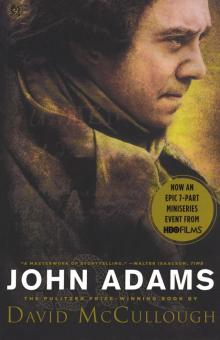 John Adams
John Adams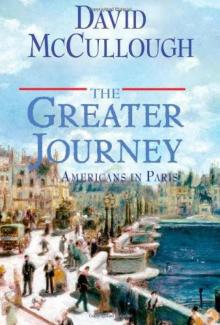 The Greater Journey: Americans in Paris
The Greater Journey: Americans in Paris 1776
1776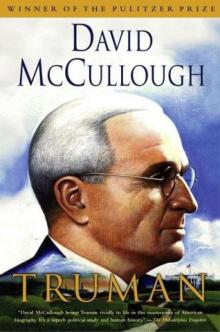 Truman
Truman The Pioneers
The Pioneers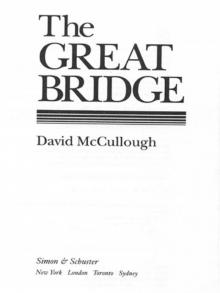 The Great Bridge: The Epic Story of the Building of the Brooklyn Bridge
The Great Bridge: The Epic Story of the Building of the Brooklyn Bridge The American Spirit
The American Spirit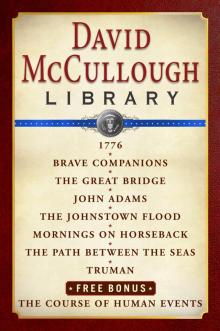 David McCullough Library E-book Box Set
David McCullough Library E-book Box Set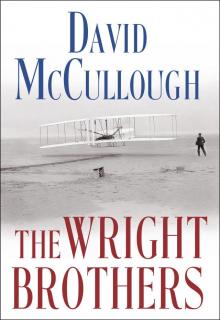 The Wright Brothers
The Wright Brothers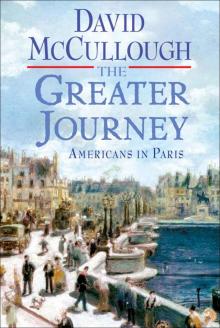 The Greater Journey
The Greater Journey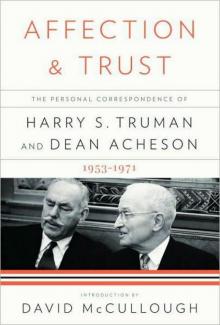 Affection and Trust: The Personal Correspondence of Harry S. Truman and Dean Acheson, 1953-1971
Affection and Trust: The Personal Correspondence of Harry S. Truman and Dean Acheson, 1953-1971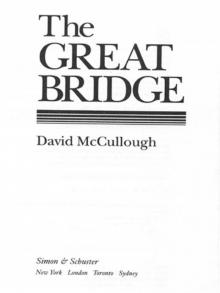 The Great Bridge
The Great Bridge